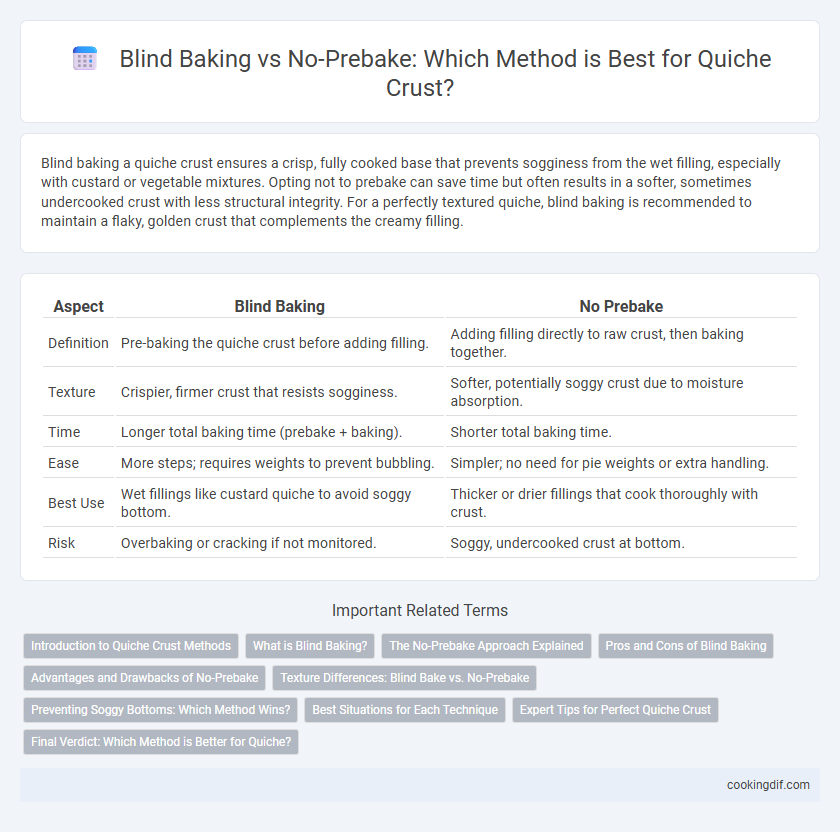Blind baking a quiche crust ensures a crisp, fully cooked base that prevents sogginess from the wet filling, especially with custard or vegetable mixtures. Opting not to prebake can save time but often results in a softer, sometimes undercooked crust with less structural integrity. For a perfectly textured quiche, blind baking is recommended to maintain a flaky, golden crust that complements the creamy filling.
Table of Comparison
| Aspect | Blind Baking | No Prebake |
|---|---|---|
| Definition | Pre-baking the quiche crust before adding filling. | Adding filling directly to raw crust, then baking together. |
| Texture | Crispier, firmer crust that resists sogginess. | Softer, potentially soggy crust due to moisture absorption. |
| Time | Longer total baking time (prebake + baking). | Shorter total baking time. |
| Ease | More steps; requires weights to prevent bubbling. | Simpler; no need for pie weights or extra handling. |
| Best Use | Wet fillings like custard quiche to avoid soggy bottom. | Thicker or drier fillings that cook thoroughly with crust. |
| Risk | Overbaking or cracking if not monitored. | Soggy, undercooked crust at bottom. |
Introduction to Quiche Crust Methods
Blind baking quiche crust involves pre-baking the dough to ensure a crisp, non-soggy base that holds up well against the creamy filling. Skipping the prebake can result in a softer, sometimes soggy crust due to the moisture from the custard mixture. Choosing the right method depends on desired texture and recipe specifics, with blind baking preferred for fully set, well-defined crust edges.
What is Blind Baking?
Blind baking is the process of pre-baking a quiche crust without the filling to prevent sogginess and ensure a crisp, flaky texture. This technique involves lining the crust with parchment paper and filling it with pie weights or dried beans to maintain its shape during baking. Blind baking is essential for custard-based quiches, where the wet filling can otherwise soak into the crust and compromise its structure.
The No-Prebake Approach Explained
The no-prebake approach for quiche crust eliminates the step of blind baking, relying on the filling's moisture to cook the crust thoroughly during baking. This method preserves a tender, flaky texture while preventing the crust from becoming overly crisp or breaking apart. Using a well-chilled dough and a longer baking time ensures the crust sets properly without pre-baking.
Pros and Cons of Blind Baking
Blind baking a quiche crust ensures a crisp, golden base that prevents sogginess caused by wet fillings, making it ideal for custard or vegetable quiches. However, blind baking requires extra time and careful monitoring to avoid shrinking or over-browning the crust. Skipping prebaking can save time but risks a soggy, undercooked crust that detracts from the overall texture and structure of the quiche.
Advantages and Drawbacks of No-Prebake
No-prebake quiche crust saves time and simplifies preparation by eliminating an initial baking step, allowing the crust to bake simultaneously with the filling. This method may result in a softer, less crisp crust and increased risk of a soggy bottom due to moisture from the custard. However, it avoids potential over-browning and shrinks less, preserving the desired texture in softer fillings.
Texture Differences: Blind Bake vs. No-Prebake
Blind baking a quiche crust produces a crisp, flaky texture as the crust cooks fully before adding the filling, preventing sogginess. In contrast, skipping the prebake often results in a softer, sometimes soggy crust due to moisture from the custard filling soaking into the dough. For a well-defined, crunchy base, blind baking remains the preferred technique in quiche preparation.
Preventing Soggy Bottoms: Which Method Wins?
Blind baking quiche crust involves pre-baking the pastry at 375degF (190degC) for 15 minutes with pie weights, creating a firm barrier that prevents the custard from seeping into the dough and causing sogginess. Skipping blind baking often results in a wet, undercooked bottom due to the moisture from eggs and cream soaking the raw crust during baking. Studies show that blind baking significantly improves crust texture by maintaining crispness and structural integrity, making it the preferred method to prevent soggy quiche bottoms.
Best Situations for Each Technique
Blind baking quiche crust is best for recipes with very wet fillings or custards, such as spinach and cheese, where pre-baking prevents sogginess and ensures a crisp, firm crust. Skipping the prebake step suits quiches with drier fillings like bacon or caramelized onions, as the crust absorbs moisture without becoming mushy, allowing it to bake fully alongside the filling. Choosing the right technique depends on balancing moisture content in the filling and desired crust texture for optimal quiche results.
Expert Tips for Perfect Quiche Crust
For a perfect quiche crust, expert tips recommend blind baking to prevent sogginess by pre-cooking the dough until it's lightly golden, ensuring a crisp, sturdy base that holds the filling without becoming soggy. Using pie weights or dried beans during blind baking maintains the crust's shape, allowing steam to escape and creating an even bake. Skipping the prebake may save time but often results in a softer, less structured crust prone to sogginess from the custard filling.
Final Verdict: Which Method is Better for Quiche?
Blind baking quiche crust ensures a crisp, golden base that prevents sogginess from the custard filling, especially important for high-moisture ingredients like vegetables. Choosing no-prebake can result in a softer, more tender crust but risks a soggy texture and uneven cooking. For a perfectly textured quiche, blind baking is generally the better method to achieve a flaky, sturdy crust that holds up well under rich fillings.
blind baking vs no-prebake for quiche crust Infographic

 cookingdif.com
cookingdif.com